Research on Energy Dissipation of Hydrofoil Cavitation Flow Field with FBDCM Model
Abstract
:1. Introduction
2. Numerical Model
2.1. Governing Equations
2.2. Filter-Based Density Modified Model
2.3. Cavitation Model
2.4. Entropy Production Equation
2.5. Geometric Dimensions Fluid Domain and Software Settings
2.6. Grid Generation and Independence Verification
3. Results and Discussion
3.1. Vortex and Cavity
3.2. Energy Analysis
4. Conclusions
- (1)
- According to the comparison with the experiment results, FBDCM can effectively capture the flow characteristics of cavity initiation, development, fracture, shedding, and collapse, revealing the complex dynamics between cavitation and vortexes. The numerical model in this paper can accurately predict the lift coefficient, drag coefficient, and the frequency of cavitation evolution.
- (2)
- The vortex dilatation term in the vorticity transport equation plays a crucial role throughout the cavitation evolution cycle. The impact of the vortex stretching term on vorticity transport is slightly greater than that of the baroclinic torque term. The vortex stretching term mainly exists on the right cavity surface of the hydrofoil and the left leakage cavity surface. In 0.3T~0.4T (cavity growing stage), the vortex dilatation term promotes the development of cavity. In 0.5T~0.8T (cavity shedding stage), the volume of the cloud cavity continues to increase, the vortex expansion ability inside the cavity weakens, and the ability of the vortex dilatation term to transport vortices decreases. The baroclinic moment term has a weak impact on the whole cavity evolution process, primarily appearing at the boundary of the cavity closure region.
- (3)
- During the phenomenon of cloud cavity shedding and collapse, the total entropy production value in the flow field is significant. When the cavity collapses, the total entropy production value reaches its peak value. The turbulent dissipation entropy production rate is predominantly localized in the fluid domain below the lifted attached cavity and within the vortex induced by the cloud cavity, accounting for over 80% of the total entropy production. The direct dissipation entropy production rate primarily occurs near the stagnation point of the hydrofoil’s leading edge and inside the cavity. The wall entropy production rate is concentrated in uncovered cavity areas, while the cavitation entropy production rate is mainly concentrated on the vapor–liquid interface.
Author Contributions
Funding
Data Availability Statement
Conflicts of Interest
Abbreviations
| BT | baroclinic torque term |
| c | chord length |
| CL | lift coefficient |
| CD | drag coefficient |
| I | turbulence intensity |
| k | turbulence kinetic energy |
| mass transfer rate | |
| m+ | condensation rate |
| m- | evaporation rate |
| p | pressure |
| RVD | vortex dilatation term |
| RVS | vortex stretching term |
| direct dissipation entropy production rate | |
| direct dissipation entropy production value | |
| turbulent dissipation entropy production rate | |
| turbulent dissipation entropy production value | |
| cavitation entropy production rate | |
| cavitation entropy production value | |
| wall entropy production rate | |
| wall entropy production value | |
| total entropy production rate | |
| total entropy production value | |
| t | time |
| ZGB | Zwart–Gerber–Belamri model |
| α | angle of attack |
| αv | vapor volume fraction |
| ε | turbulence dissipation rate |
| ρ | density |
| σ | cavitation number |
| μ | dynamic viscosity |
| Subscripts | |
| eff | effective value |
| i,j,1,2,3 | direction of the Cartesian coordinates |
| l | liquid phase |
| m | mixture |
| T | temperature |
| v | vapor phase |
References
- Kollek, W.; Kudźma, Z.; Stosiak, M.; Mackiewicz, J. Possibilities of diagnosing cavitation in hydraulic systems. Arch. Civ. Mech. Eng. 2007, 7, 61–73. [Google Scholar] [CrossRef]
- Liu, Y.; Li, X.; Wang, W.; Li, L.; Huo, Y. Numerical investigation on the evolution of cavitating dynamics and energy loss around a hydrofoil in fluoroketone under different temperatures. Ocean Eng. 2023, 287, 115856. [Google Scholar] [CrossRef]
- Karpenko, M. Aircraft hydraulic drive energy losses and operation delay associated with the pipeline and fitting connections. Aviation 2024, 28, 1–8. [Google Scholar] [CrossRef]
- Bejan, A.; Kestin, J. Entropy Generation through Heatand Fluid Flow; John Wiley & Sons Inc.: New York, NY, USA, 1982. [Google Scholar] [CrossRef]
- Kock, F.; Herwig, H. Local entropy production in turbulent shear flows: A high-Reynolds number model with wall functions. Int. J. Heat Mass Transf. 2003, 47, 2205–2215. [Google Scholar] [CrossRef]
- Wang, W.; Wang, J.; Li, J.; Liang, Z. Entropy generation rates calculation in turbulent flow through an airfoil based on eddy viscosity models. Chin. J. Comput. Mech. 2018, 35, 387–392. [Google Scholar] [CrossRef]
- Zhang, Y.; Yang, B.; Chen, W.; Chen, H.; Xiang, L. Study on Cavitation Characteristics of Hydrofoil Based on Entropy Production Theory. J. Propuls. Technol. 2019, 40, 1490–1497. [Google Scholar] [CrossRef]
- Yu, A.; Tang, Q.; Zhou, D. Entropy production analysis in thermodynamic cavitating flow with the consideration of local compressibility. Int. J. Heat Mass Transf. 2020, 153, 119604. [Google Scholar] [CrossRef]
- Gu, Y.; Qiu, Q.; Ren, Y.; Ma, L.; Ding, H.; Hu, C.; Wu, D.; Mou, J. Cavitation flow of hydrofoil surface and turbulence model applicability analysis. Int. J. Mech. Sci. 2024, 277, 109515. [Google Scholar] [CrossRef]
- He, Z.; Guan, W.; Wang, C.; Guo, G.; Zhang, L.; Gavaises, M. Assessment of turbulence and cavitation models in prediction of vortex induced cavitating flow in fuel injector nozzles. Int. J. Multiph. Flow 2022, 157, 104251. [Google Scholar] [CrossRef]
- Johansen, S.T.; Wu, J.; Shyy, W. Filter-based unsteady RANS computations. Int. J. Heat Fluid Flow 2003, 25, 10–21. [Google Scholar] [CrossRef]
- Coutier-Delghosa, O.; Fortes-Patella, R.; Reboud, J.L. Evaluation of the Turbulence Model Influence on the Numerical Sim-ulations of Unsteady Cavitation. J. Fluids Eng. 2003, 125, 38–45. [Google Scholar] [CrossRef]
- Liu, J.; Yu, J.; Yang, Z.; He, Z.; Yuan, K.; Guo, Y.; Li, Y. Numerical investigation of shedding dynamics of cloud cavitation around 3D hydrofoil using different turbulence models. Eur. J. Mech. B/Fluids 2021, 85, 232–244. [Google Scholar] [CrossRef]
- Yin, T.; Pavesi, G.; Pei, J.; Yuan, S. Numerical analysis of unsteady cloud cavitating flow around a 3D Clark-Y hydrofoil considering end-wall effects. Ocean Eng. 2021, 219, 108369. [Google Scholar] [CrossRef]
- Huang, B.; Wang, G.; Zhao, Y. Numerical simulation unsteady cloud cavitating flow with a filter-based density correction model. J. Hydrodyn. 2014, 26, 26–36. [Google Scholar] [CrossRef]
- Huang, B.; Wang, G.; Yuan, H.; Wang, F. Assessment of a Density Modify Based Turbulence Closure for Unsteady Cavitating Flows. Trans. Beijing Inst. Technol. 2010, 30, 1170–1174. [Google Scholar] [CrossRef]
- Suarez, S.; Puyol, R.; Schafer, C.; Mucklich, F. Numerical investigation of dynamics of unsteady sheet/cloud cavitating flow using a compressible fluid model. Mod. Phys. Lett. B 2015, 29, 1450269. [Google Scholar] [CrossRef]
- Zwart, P.J.; Gerber, A.G.; Belamri, T. A two-phase flow model for predicting cavitation dynamics. In Proceedings of the 5th International Conference on Multiphase Flow, Yokohama, Japan, 30 May–4 June 2004. [Google Scholar]
- Suarez, S.; Puyol, R.; Schafer, C.; Mucklich, F. Lift-drag characteristics of S-shaped hydrofoil under different cloud cavitation conditions. Ocean Eng. 2023, 278, 114374. [Google Scholar] [CrossRef]
- Suarez, S.; Puyol, R.; Schafer, C.; Mucklich, F. Thermodynamic effect on attached cavitation and cavitation-turbulence interaction around a hydrofoil. Ocean Eng. 2023, 281, 114764. [Google Scholar] [CrossRef]
- Suarez, S.; Puyol, R.; Schafer, C.; Mucklich, F. Numerical Prediction of Cavitating Flow on a Two-Dimensional Symmetrical Hydrofoil and Comparison to Experiments. J. Fluids Eng. 2007, 129, 279–292. [Google Scholar] [CrossRef]
- Yu, A.; Li, L.; Zhou, D.; Ji, J. Large eddy simulation of the pulsation characteristics in the cavitating flow around a NACA0015 hydrofoil. Ocean Eng. 2023, 267, 113289. [Google Scholar] [CrossRef]
- Liu, Y.; Li, X.; Ge, M.; Li, L.; Zhu, Z. Numerical investigation of transient liquid nitrogen cavitating flows with special emphasis on force evolution and entropy features. Cryogenics 2021, 113, 103225. [Google Scholar] [CrossRef]
- Kock, F.; Herwig, H. Entropy production calculation for turbulent shear flows and their implementation in cfd codes. Int. J. Heat Fluid Flow 2005, 26, 672–680. [Google Scholar] [CrossRef]
- Zhang, X.; Wang, Y.; Xu, X.; Wang, H. Energy Conversion Characteristic within Impeller of Low Specific Speed Centrifugal Pump. Nongye Jixie Xuebao 2011, 42, 75–81. [Google Scholar] [CrossRef]
- Wu, Q.; Huang, B.; Wang, G.; Gao, Y. Experimental and numerical investigation of hydroelastic response of a flexible hydrofoil in cavitating flow. Int. J. Multiph. Flow 2015, 74, 19–33. [Google Scholar] [CrossRef]

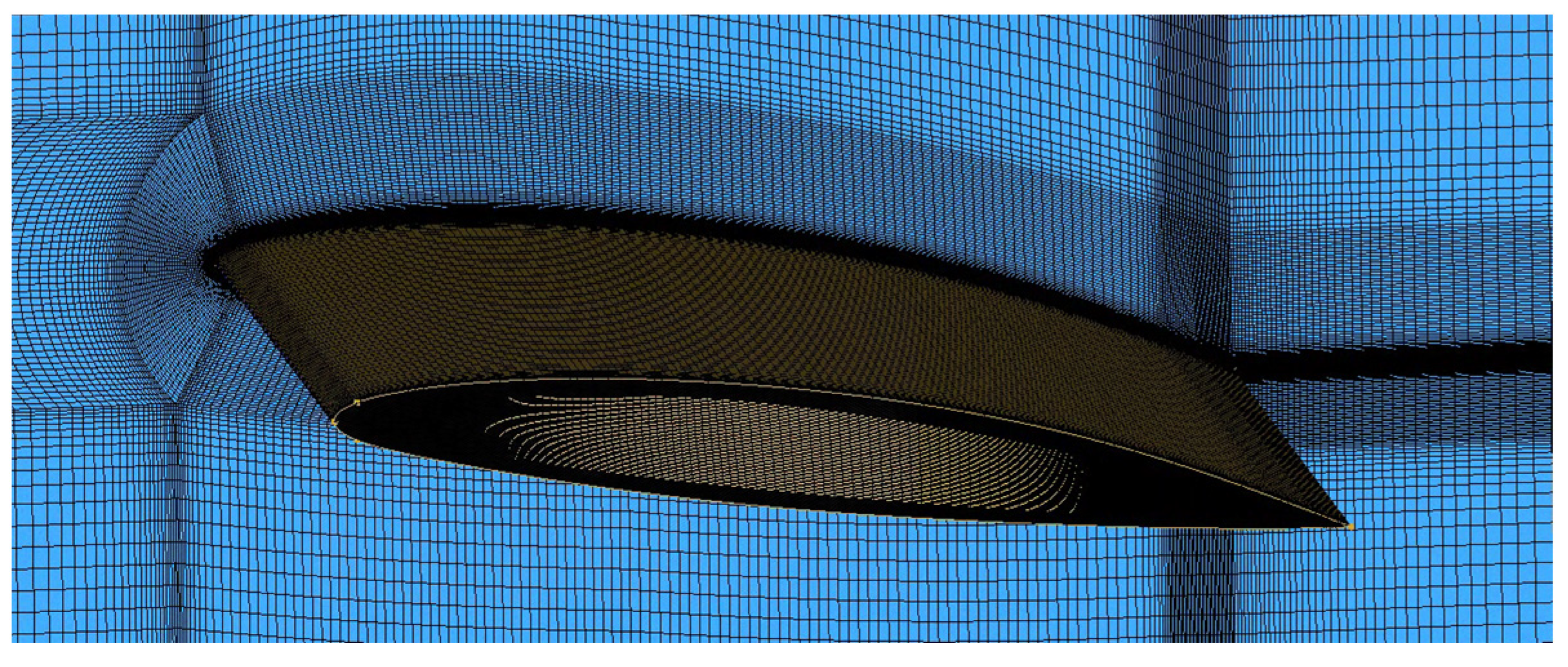
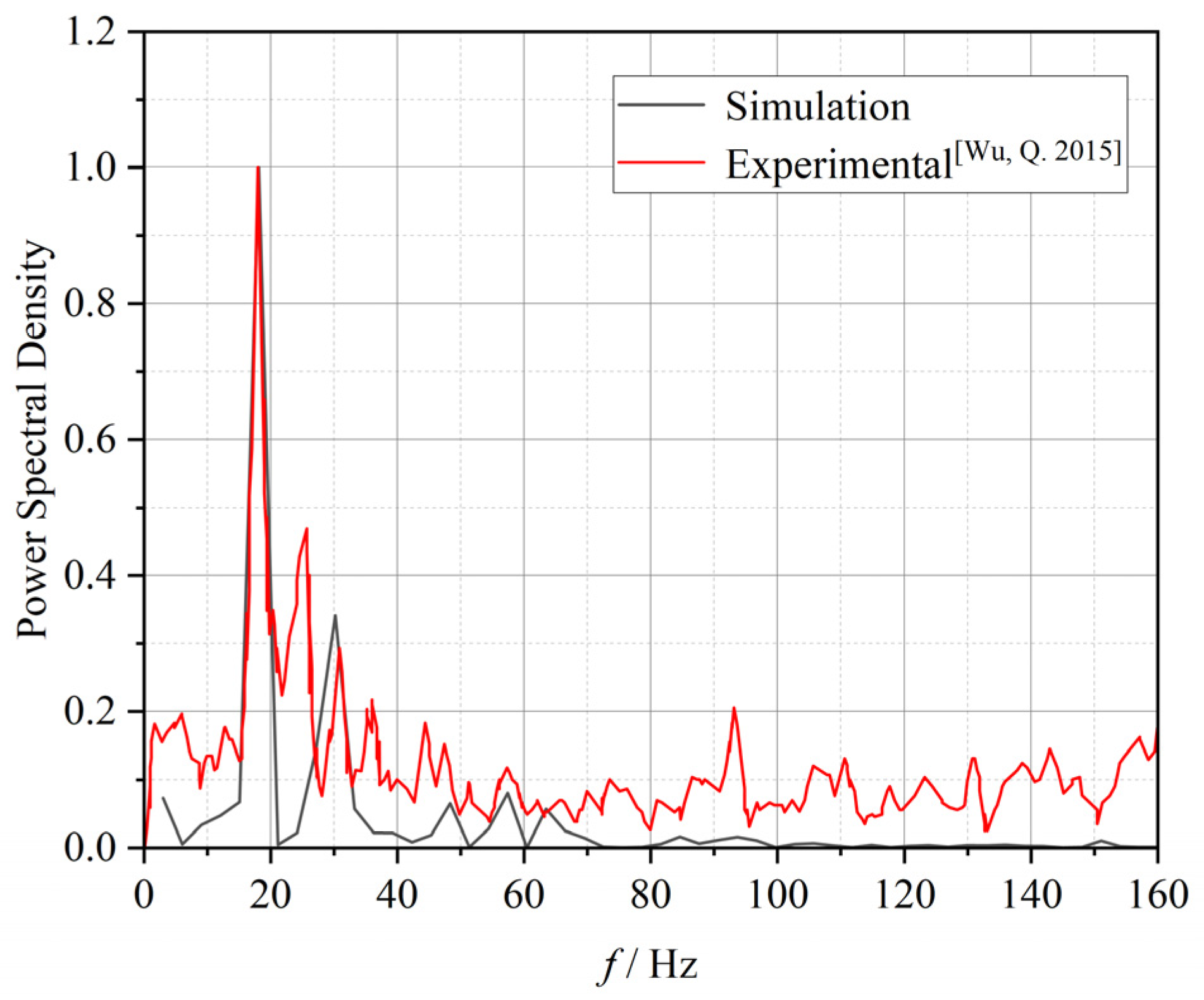
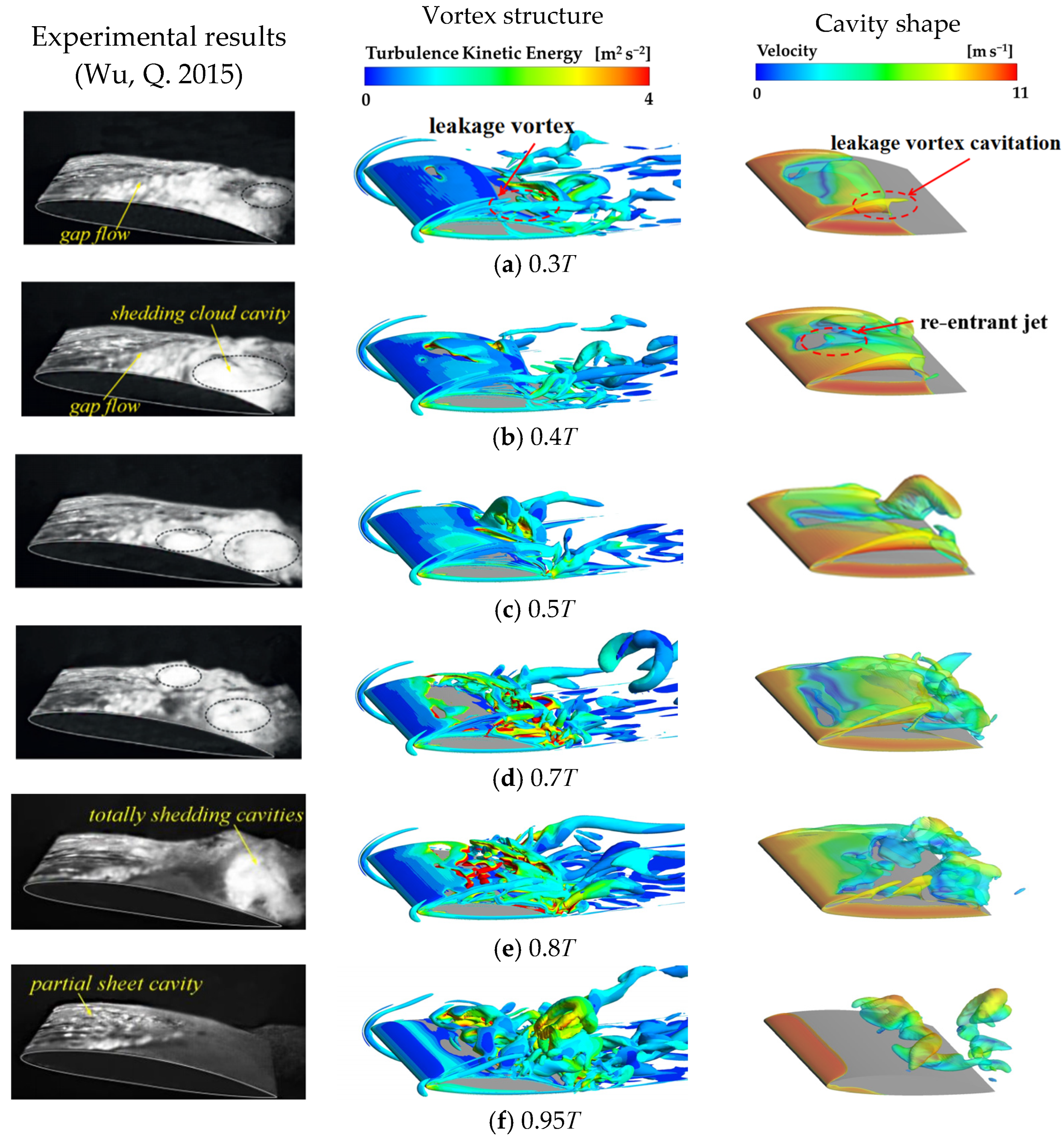


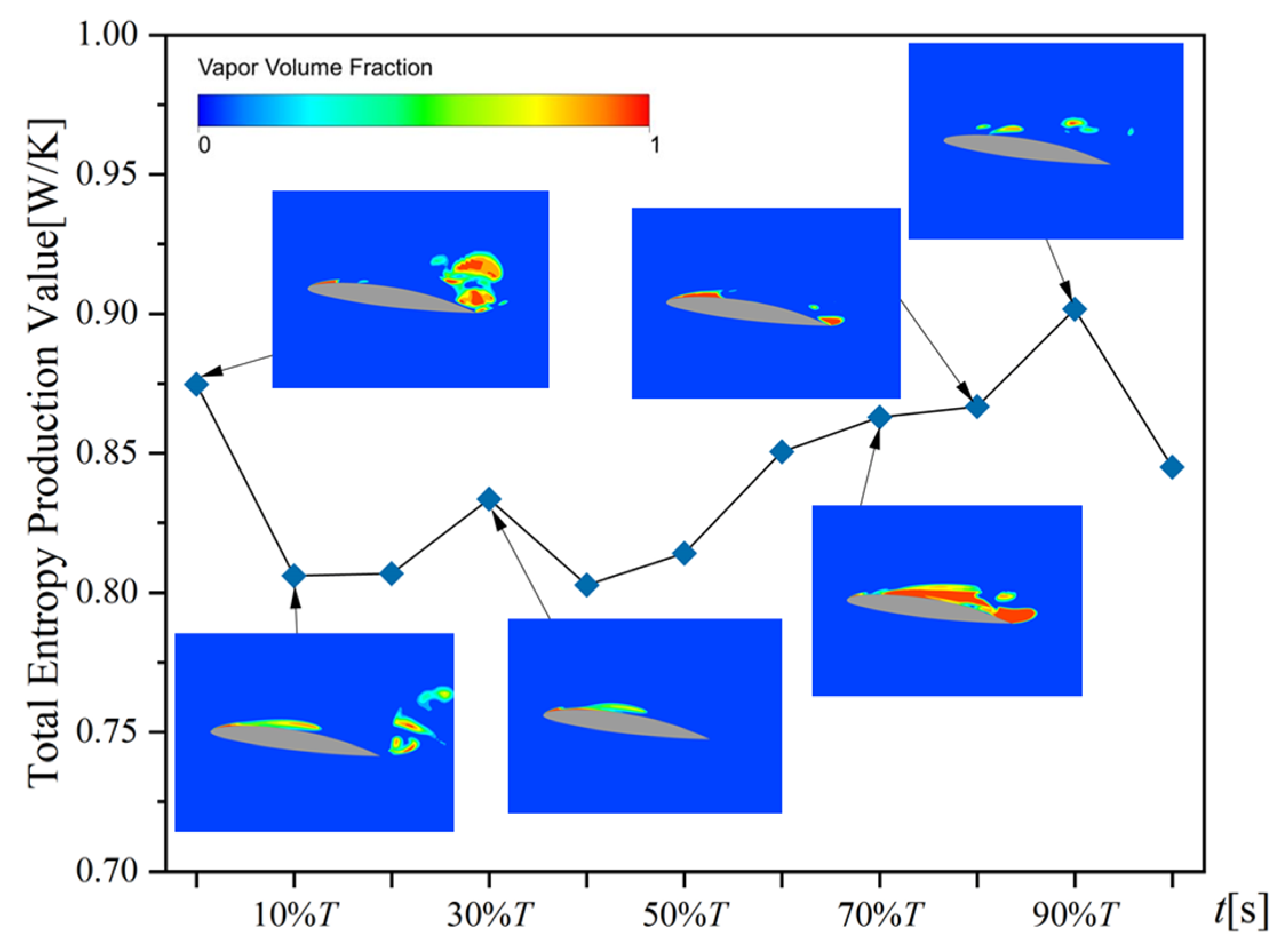
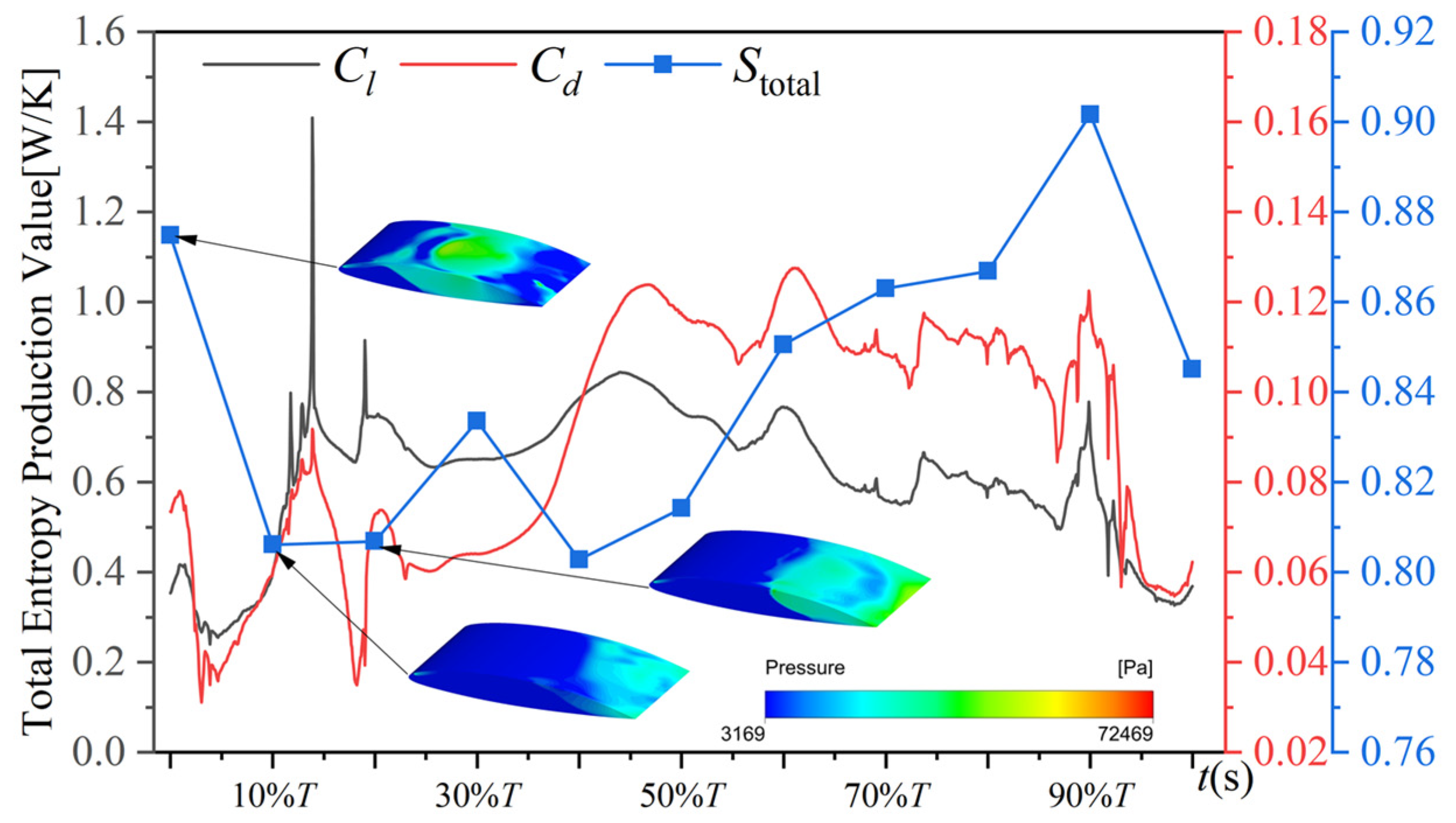
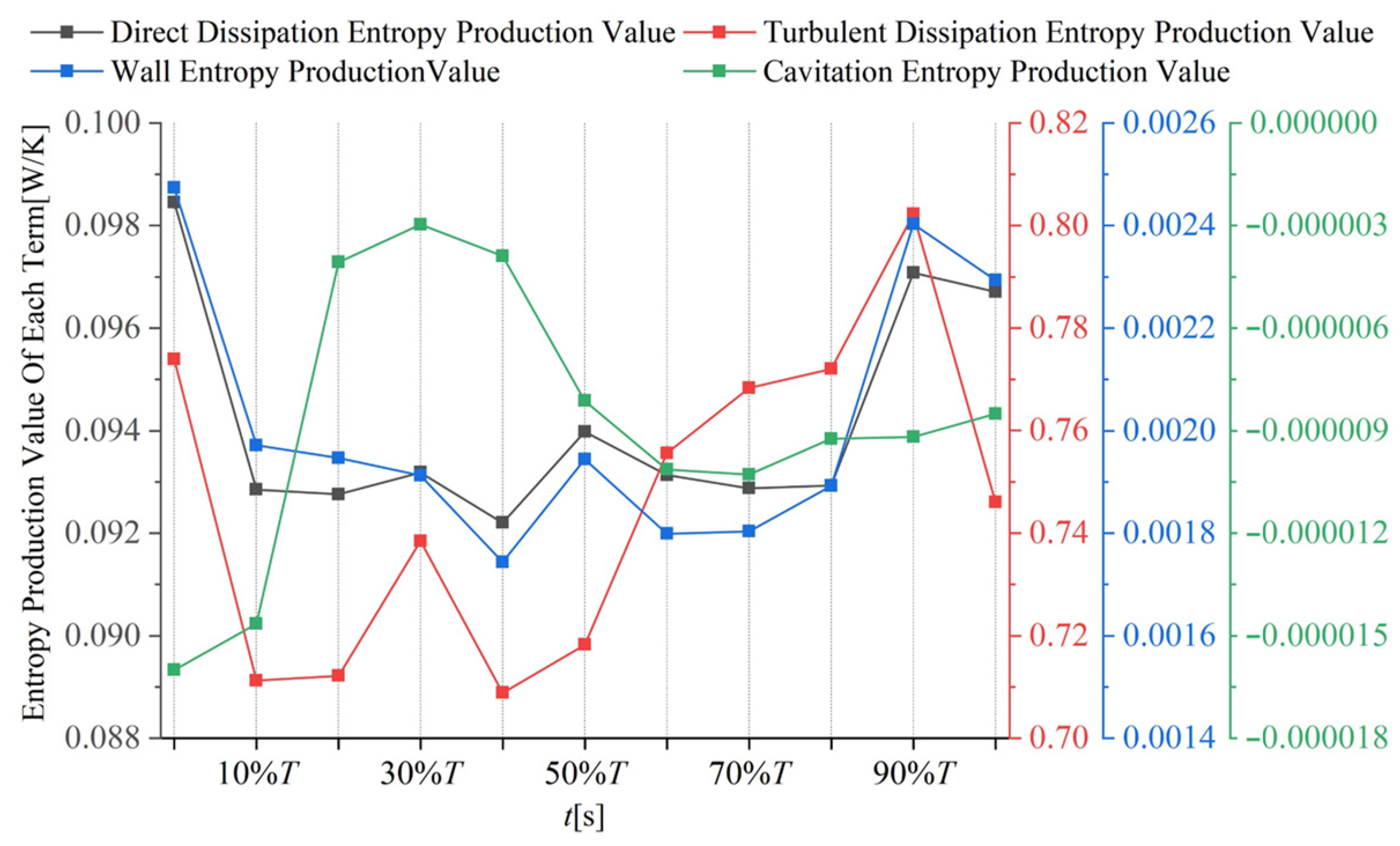


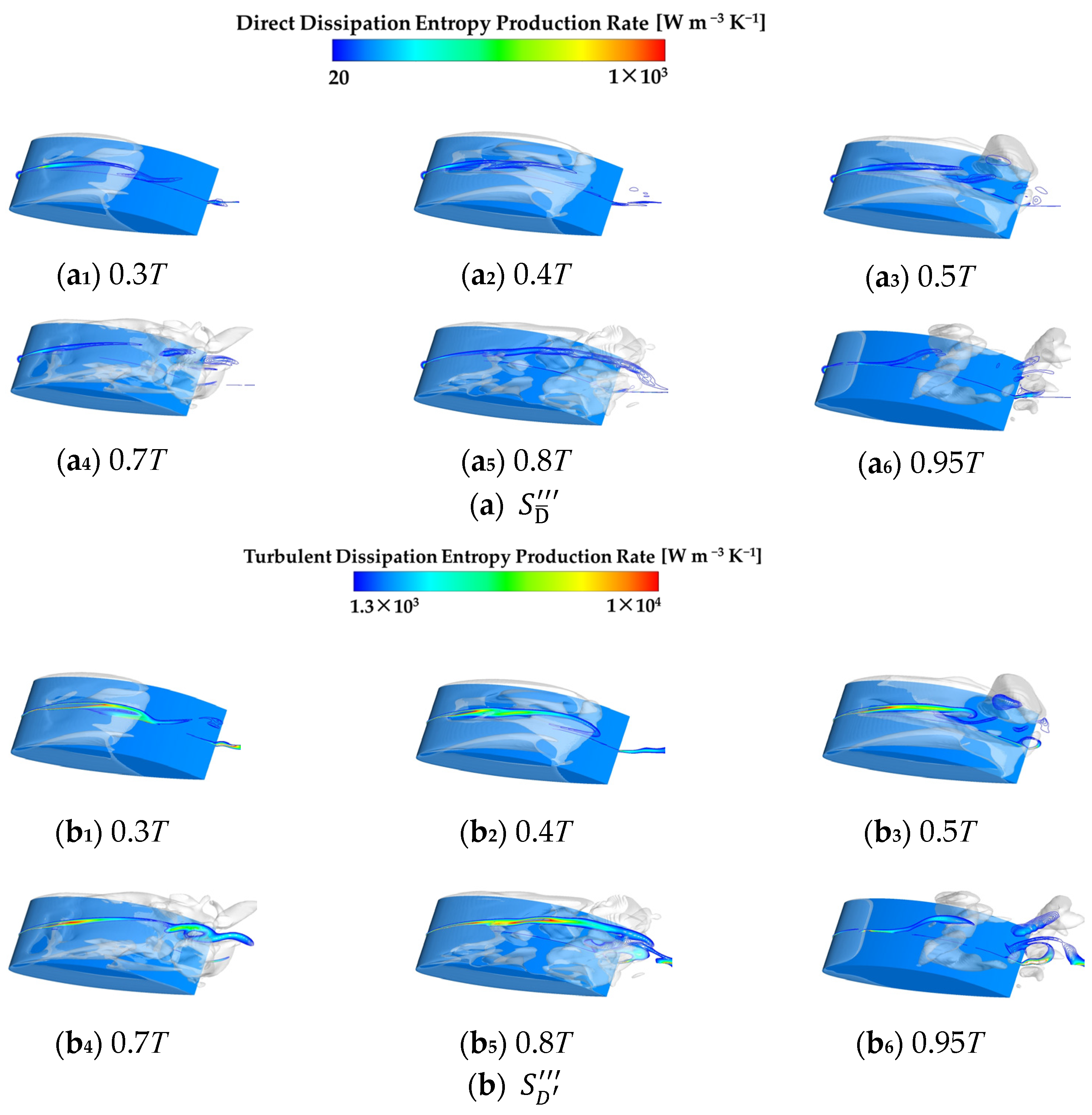


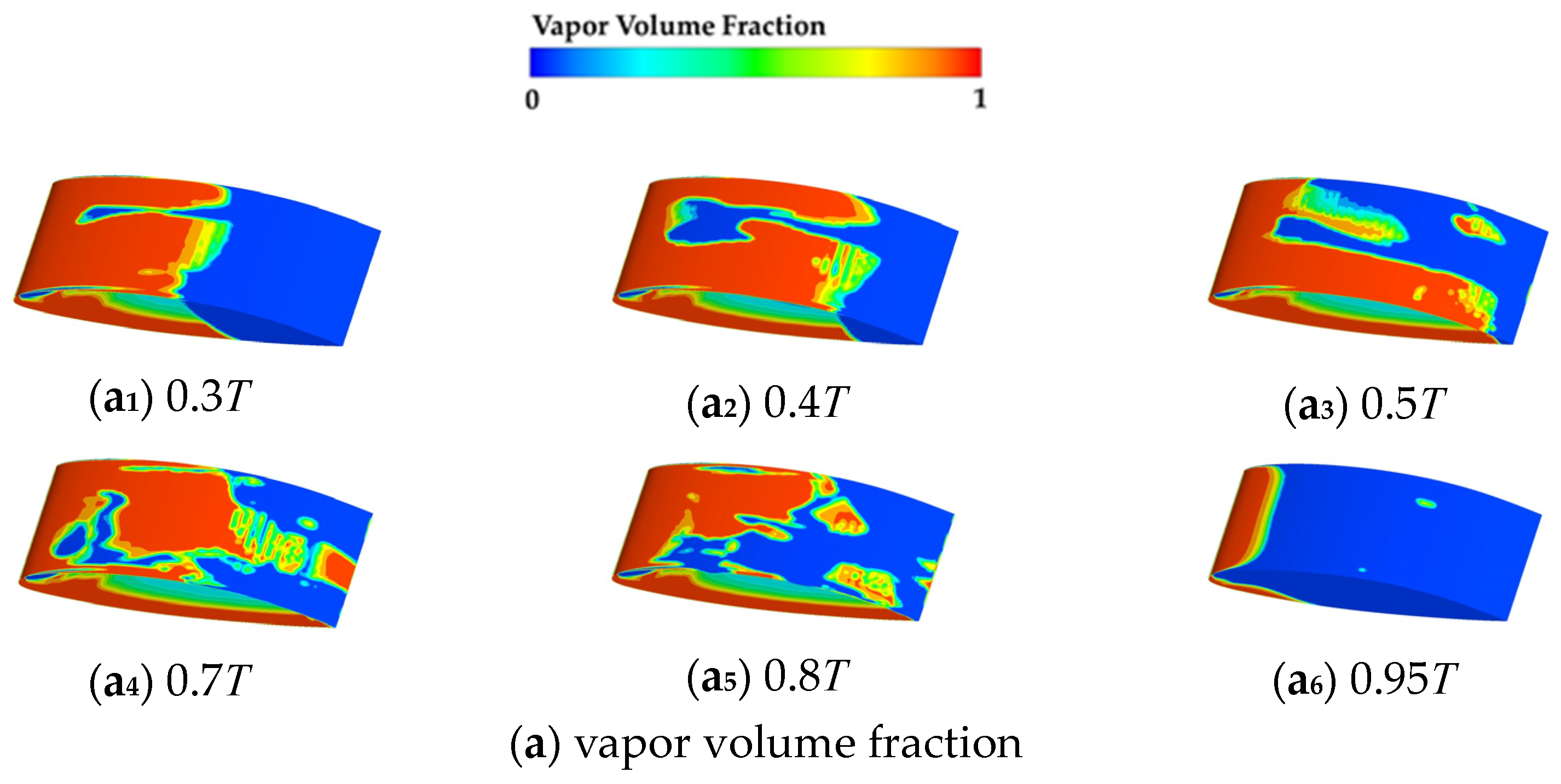
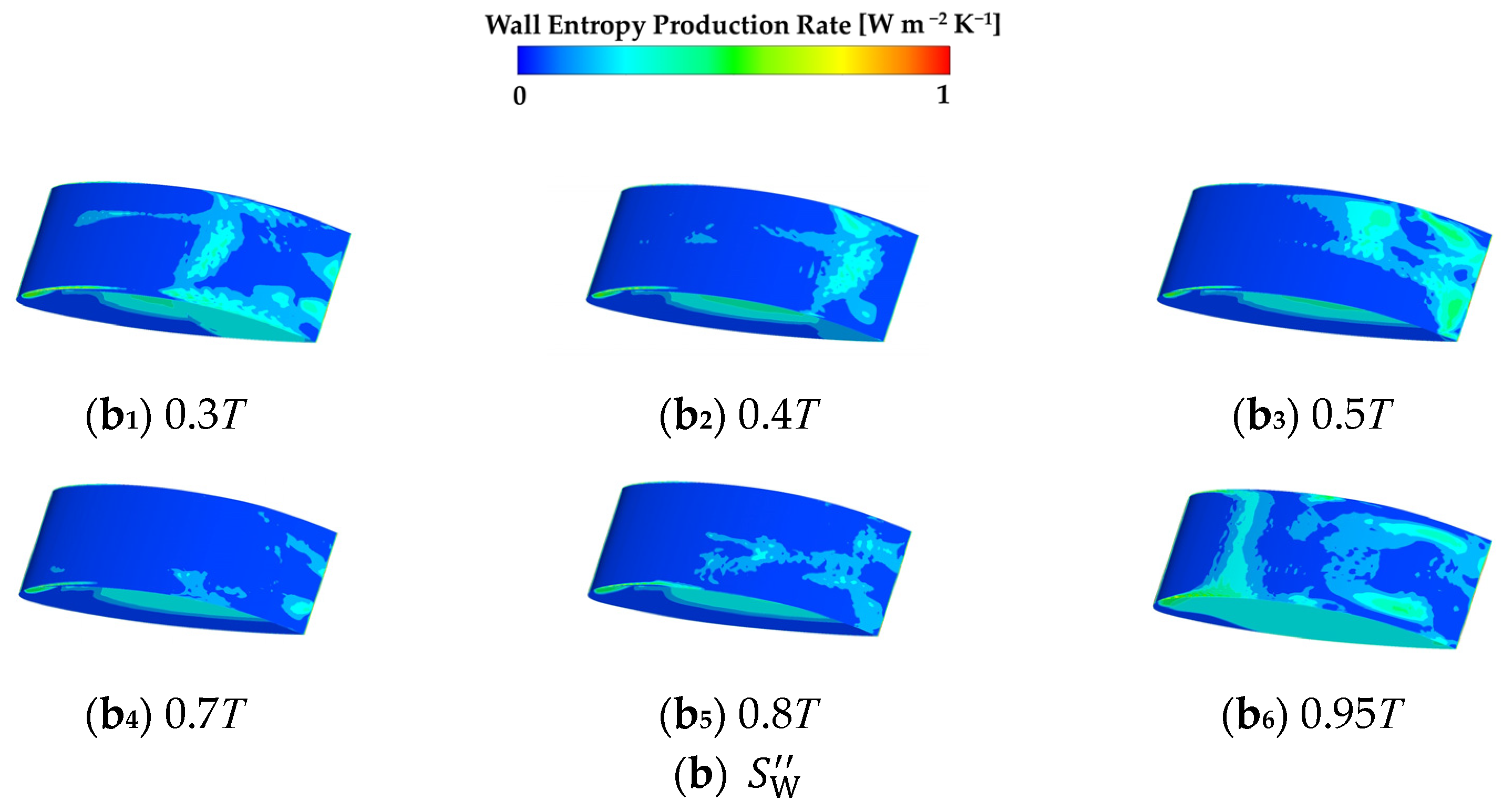
| Number of Cells | CL | CD | f | |
|---|---|---|---|---|
| M1 | 3,036,694 | 0.602 | 0.085 | 18.25 |
| M2 | 5,618,224 | 0.608 | 0.087 | 18.11 |
| M3 | 8,199,754 | 0.614 | 0.088 | 18.09 |
| M4 | 10,781,284 | 0.616 | 0.088 | 18.08 |
| Exp. [26] | - | 0.620 | 0.090 | 18.05 |
Disclaimer/Publisher’s Note: The statements, opinions and data contained in all publications are solely those of the individual author(s) and contributor(s) and not of MDPI and/or the editor(s). MDPI and/or the editor(s) disclaim responsibility for any injury to people or property resulting from any ideas, methods, instructions or products referred to in the content. |
© 2024 by the authors. Licensee MDPI, Basel, Switzerland. This article is an open access article distributed under the terms and conditions of the Creative Commons Attribution (CC BY) license (https://creativecommons.org/licenses/by/4.0/).
Share and Cite
Huang, R.; Wang, Y.; Xu, H.; Qiu, C.; Ma, W. Research on Energy Dissipation of Hydrofoil Cavitation Flow Field with FBDCM Model. Processes 2024, 12, 1780. https://doi.org/10.3390/pr12081780
Huang R, Wang Y, Xu H, Qiu C, Ma W. Research on Energy Dissipation of Hydrofoil Cavitation Flow Field with FBDCM Model. Processes. 2024; 12(8):1780. https://doi.org/10.3390/pr12081780
Chicago/Turabian StyleHuang, Rui, Yulong Wang, Haitao Xu, Chaohui Qiu, and Wei Ma. 2024. "Research on Energy Dissipation of Hydrofoil Cavitation Flow Field with FBDCM Model" Processes 12, no. 8: 1780. https://doi.org/10.3390/pr12081780





